_1972-73.JPEG.webp)
American units that operated the F-4 Phantom II are listed below.
U.S. Air Force

Following the test and evaluation of loaned Navy F-4Bs, the first production F-4C was delivered to U.S. Air Force in November 1963. The 4453rd Combat Crew Training Wing at MacDill AFB was the first unit to receive the Phantoms. The first combat unit to receive F-4Cs was the 12th Tactical Fighter Wing in 1964.[1]
 B83 nuclear bomb test with F-4C Phantom 1983
B83 nuclear bomb test with F-4C Phantom 1983 F-4C Phantom II of 557th TFS over Vietnam in 1969
F-4C Phantom II of 557th TFS over Vietnam in 1969 F-4C Phantom with AGM-12 Bullpups
F-4C Phantom with AGM-12 Bullpups F-4C Phantoms with AIM-7 missiles at Cam Ranh 1967
F-4C Phantoms with AIM-7 missiles at Cam Ranh 1967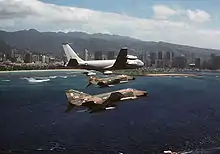 F-4Cs HawaiiANG KC-135A 1979
F-4Cs HawaiiANG KC-135A 1979 F-4Cs RB-66C bombing Vietnam 1966
F-4Cs RB-66C bombing Vietnam 1966 F-4Cs 18th TFW deploy at CCK Air Base Taiwan 1973
F-4Cs 18th TFW deploy at CCK Air Base Taiwan 1973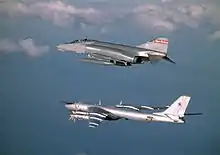 F-4D 119th FW inctercepting Tu-95 1983
F-4D 119th FW inctercepting Tu-95 1983 F-4D 171st FIS Michigan ANG in flight 1987
F-4D 171st FIS Michigan ANG in flight 1987 F-4D 435th TFS approaches tanker over Vietnam
F-4D 435th TFS approaches tanker over Vietnam F-4D 13th TFS leads VF-151 F-4Bs on bombing mission 1971
F-4D 13th TFS leads VF-151 F-4Bs on bombing mission 1971 F-4D North Dakota ANG launches AIM-7 1983
F-4D North Dakota ANG launches AIM-7 1983 F-4D 924th TFW AFRES at Kunsan AB 1985
F-4D 924th TFW AFRES at Kunsan AB 1985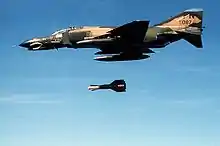 F-4E 3rd TFW dropping GBU-15 1985
F-4E 3rd TFW dropping GBU-15 1985 F-4E 497th TFS over Korea 1986
F-4E 497th TFS over Korea 1986 F-4E 347th TFW A-7Ds 114th TFG Panama 1979
F-4E 347th TFW A-7Ds 114th TFG Panama 1979 F-4E with Pave Tack near Eglin AFB 1976
F-4E with Pave Tack near Eglin AFB 1976 F-4Es 57FIS Tu95D 1980
F-4Es 57FIS Tu95D 1980 F-4G F-4Es 52TFW 1984
F-4G F-4Es 52TFW 1984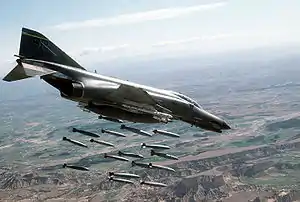 F-4E-81st-tfs
F-4E-81st-tfs F-4G 81st TFS serviced at Spangdahlem 1990
F-4G 81st TFS serviced at Spangdahlem 1990 F-4Gs 35th TFW over Saudi desert 1991
F-4Gs 35th TFW over Saudi desert 1991 F-4G 480th TFS with F-16C 52nd TFW in flight 1989
F-4G 480th TFS with F-16C 52nd TFW in flight 1989 F-4E Phantom launches AGM-45
F-4E Phantom launches AGM-45 RF-4C Kentucky ANG from below 1986
RF-4C Kentucky ANG from below 1986 RF-4C Phantom 16th TRS in Vietnam c1965
RF-4C Phantom 16th TRS in Vietnam c1965 RF-4C Kentucky ANG over Germany 1983
RF-4C Kentucky ANG over Germany 1983 RF-4C Phantom firing rocket
RF-4C Phantom firing rocket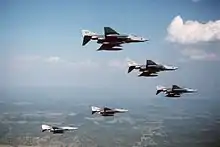 RF-4Cs 67th TRW in flight 1988
RF-4Cs 67th TRW in flight 1988 RF-4Cs 26th TRW over Germany c1985
RF-4Cs 26th TRW over Germany c1985 An air-to-air left underside view of four 37th Tactical Fighter Wing F-4E Phantom II aircraft in formation during the Tactical Air Command bombing and gunnery competition Gunsmoke '85 DF-ST-87-03762
An air-to-air left underside view of four 37th Tactical Fighter Wing F-4E Phantom II aircraft in formation during the Tactical Air Command bombing and gunnery competition Gunsmoke '85 DF-ST-87-03762
List of units:[2]
- 301st Tactical Fighter Wing - Carswell AFB, Texas (F-4D, F-4E)
- 482d Tactical Fighter Wing - Homestead AFB, Florida (F-4C, F-4D)
- 924th Tactical Fighter Group - Bergstrom AFB, Texas (F-4D, F-4E)

- 116th Reconnaissance Squadron, 117th Reconnaissance Wing (RF-4C)
- 184th Tactical Fighter Squadron, 188th Tactical Fighter Group (F-4C)
- 194th Fighter Interceptor Squadron, 144th Fighter Interceptor Wing (F-4D)
- 196th Tactical Fighter Squadron, 163rd Tactical Fighter Group (F-4C, F-4E)
- 196th Reconnaissance Squadron, 163rd Reconnaissance Group (RF-4C)
- 121st Tactical Fighter Squadron, 113th Tactical Fighter Wing (F-4D)
- 128th Tactical Fighter Squadron, 116th Tactical Fighter Wing (F-4D)
- 199th Tactical Fighter Squadron, 154th Group (F-4C)
- Reconnaissance Weapons School, 189th Tactical Reconnaissance Training Flight, 190th Tactical Reconnaissance Squadron, 124th Tactical Reconnaissance Group (RF-4C)
- 190th Fighter Squadron, 124th Fighter Group (RF-4C, F-4G)
- 170th Tactical Fighter Squadron, 183rd Tactical Fighter Group (F-4C, F-4D)
- 163d Tactical Fighter Squadron, 122d Tactical Fighter Group (F-4C and F-4E)
- 113th Tactical Fighter Squadron, 181st Tactical Fighter Group (F-4C and F-4E)
- 127th Tactical Fighter Squadron and 177th Tactical Fighter Training Squadron, 184th Tactical Fighter Group (F-4D)
- 165th Tactical Reconnaissance Squadron, 123d Tactical Reconnaissance Wing (RF-4C)
- 122d Tactical Fighter Squadron, 159th Tactical Fighter Group (F-4C)
- 171st Tactical Fighter Squadron, 191st Tactical Fighter Group (F-4C and F-4D)
- 179th Tactical Reconnaissance Squadron, 179th Fighter-Interceptor Squadron; 148th Tactical Reconnaissance Group, 148th Fighter Interceptor Group (RF-4C and F-4D)
- 153d Tactical Reconnaissance Squadron; 186th Tactical Reconnaissance Group (RF-4C)
- 110th Tactical Fighter Squadron, 131st Tactical Fighter Group (F-4C and F-4E)
- 173d Tactical Reconnaissance Squadron, 173d Reconnaissance Squadron; 155th Tactical Reconnaissance Group, 155th Reconnaissance Group (RF-4C)
- 192d Tactical Reconnaissance Squadron, later 192d Reconnaissance Squadron; 152d Tactical Reconnaissance Group, later 152d Reconnaissance Group (RF-4C)
- 141st Tactical Fighter Squadron, 108th Tactical Fighter Group (F-4D and F-4E)
- 136th Fighter-Interceptor Squadron, 107th Fighter-Interceptor Group (F-4C and F-4D)
- 178th Fighter-Interceptor Squadron, 119th Fighter-Interceptor Group (F-4D)
- 123d Fighter-Interceptor Squadron, 142d Fighter-Interceptor Wing (F-4C)
- 111th Fighter-Interceptor Squadron, 147th Fighter-Interceptor Wing (F-4C and F-4D)
- 182d Tactical Fighter Squadron, 149th Tactical Fighter Group (F-4C)
- 134th Tactical Fighter Squadron, 158th Tactical Fighter Group (F-4D)
U.S. Navy

The Phantom entered service with the U.S. Navy on 30 December 1960 with the VF-121 Pacemakers at NAS Miramar. The VF-74 Be-devilers at NAS Oceana became the first deployable Phantom squadron when it received its F4H-1s (F-4Bs) on 8 July 1961.[3]
Frontline & Reserve
- U.S. Atlantic Fleet / Naval Air Force Atlantic - All based at NAS Oceana, Virginia
- U.S. Pacific Fleet / Naval Air Force Pacific - All based at NAS Miramar, California with exception of two squadrons forward deployed to / based at NAF Atsugi, Japan
- VF-21 "Freelancers"
- VF-154 "Black Knights"
- VF-51 "Screaming Eagles"
- VF-111 "Sundowners"
- VF-92 "Silver Kings"
- VF-96 "Fighting Falcons"
- VF-114 "Aardvarks"
- VF-213 "Black Lions"
- VF-142 "Ghostriders" (Later transferred to Atlantic Fleet prior to conversion to the F-14 Tomcat)
- VF-143 "Pukin Dogs" (Later transferred to Atlantic Fleet prior to conversion to the F-14 Tomcat)
- VF-151 "Vigilantes"
- VF-161 "Chargers"
- VF-191 "Satan's Kittens"
- VF-194 "Red Lightnings"
- United States Naval Reserve / Naval Air Reserve Force
- VF-201 "Hunters" (Atlantic Fleet) - Based at NAS Dallas, Texas
- VF-202 "Superheats" (Atlantic Fleet) - Based at NAS Dallas, Texas
- VF-301 "Devil's Disciples" (Pacific Fleet) - Based at NAS Miramar, California
- VF-302 "Stallions" (Pacific Fleet) - Based at NAS Miramar, California
- VF-22L1 {no nickname assigned} (Pacific Fleet) - Based at NAS Los Alamitos, California; later merged into VF-301 and VF-302 at NAS Miramar
 An F-4J Phantom II of Fighter Squadron VF-92 Silver Kings, from the USS Constellation
An F-4J Phantom II of Fighter Squadron VF-92 Silver Kings, from the USS Constellation F-4B Phantom of VF-161 intercepting Soviet Tu-95 in 1971
F-4B Phantom of VF-161 intercepting Soviet Tu-95 in 1971 F-4J Phantom II of VF-33 in flight in 1970
F-4J Phantom II of VF-33 in flight in 1970_in_1981.JPEG.webp) F-4S of VF-161 landing on USS Midway (CV-41) in 1981
F-4S of VF-161 landing on USS Midway (CV-41) in 1981 F-4B Phantom of VF-21 dropping bombs over Vietnam 1965
F-4B Phantom of VF-21 dropping bombs over Vietnam 1965 F-4J Phantom of VF-102 in flight c1977
F-4J Phantom of VF-102 in flight c1977 F-4J Phantom of VF-114 intercepting Soviet Tu-16 1975
F-4J Phantom of VF-114 intercepting Soviet Tu-16 1975 F-4B Phantoms VF-51 Screaming Eagles in flight c1971
F-4B Phantoms VF-51 Screaming Eagles in flight c1971 F-5E and F-4S during air combat maneuvering in 1982
F-5E and F-4S during air combat maneuvering in 1982 TA-4F of VC-13 and F-4N of VF-301 during air combat maneuvering 1979
TA-4F of VC-13 and F-4N of VF-301 during air combat maneuvering 1979 F-4S VF-301 in steep climb 1984
F-4S VF-301 in steep climb 1984 F-4J Phantoms of VF-21 and VF-154 in flight c1970
F-4J Phantoms of VF-21 and VF-154 in flight c1970 F-4J Phantoms of VF-194 at NAS Miramar 1976
F-4J Phantoms of VF-194 at NAS Miramar 1976 F-4J Phantoms of VF-142 in flight c1971
F-4J Phantoms of VF-142 in flight c1971 F-4J Phantom II of VF-31 in flight c1978
F-4J Phantom II of VF-31 in flight c1978 F-4J from VF-21 launching Sparrow missile c1970
F-4J from VF-21 launching Sparrow missile c1970 F-4S Phantom IIs of VF-103 in flight over Nevada in 1982
F-4S Phantom IIs of VF-103 in flight over Nevada in 1982 F-4B VF-151 CV-41 TU-95
F-4B VF-151 CV-41 TU-95
Fleet Replacement Training
_c1984.jpeg.webp)
These kind of units are known in Navy parlance as Replacement Air Groups (RAG) or Fleet Replacement Squadrons (FRS). The purpose of these particular training units was to provide fleet squadrons with F-4 Phantom-qualified aircrew and maintenance personnel. During the Vietnam War, they also furnished spare aircraft to replace those lost in combat.
- VF-101 "Grim Reapers" (Atlantic Fleet) - Based at NAS Oceana, Virginia
- The DACT detachment of VF-101 was located at NAS Key West, Florida and flew both the A-4 Skyhawk and the F-4 Phantom II.
- VF-121 "Pacemakers" (Pacific Fleet) - Based at NAS Miramar, California
- VF-171 "Aces" (Atlantic Fleet) - Based at NAS Oceana, Virginia.
- The DACT detachment of VF-171 was located at NAS Key West, Florida, and flew the A-4 Skyhawk and the F-4 Phantom II. VF-171 assumed the Atlantic Fleet F-4 Fleet Replacement Squadron training role upon VF-101's transition to becoming the Fleet Replacement Squadron for the F-14 Tomcat.
Fleet Support
These units provided services to the fleet such as air combat training and enemy electronic warfare simulation support.
 F-4A F-8C and A-4B of VC-7 in flight c1968
F-4A F-8C and A-4B of VC-7 in flight c1968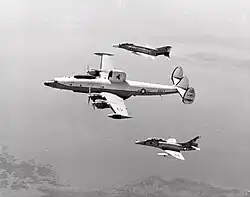 Warning Star Skyhawk Phantom VAQ-33 1973
Warning Star Skyhawk Phantom VAQ-33 1973
- VC-7 "Tallyhoers" - Based at NAS Miramar, California
- VAQ-33 "Firebirds" - Initially based at NAS Norfolk, Virginia; later transferred to NAS Key West, Florida in 1980
Flight Demonstration, Development, Test & Evaluation

- U.S. Navy Flight Demonstration Squadron, the Blue Angels - Based at NAS Pensacola, Florida with winter training detachment operations at NAF El Centro, California (1969-1974)
- VX-4 "Evaluators" - Based at NAS Point Mugu, California
- VX-5 "Vampires" - Based at NAS China Lake, California
- VX-30 "Bloodhounds" - Based at NAS Point Mugu, California
- Strike Aircraft Test Directorate - Based at NAS Patuxent River, Maryland
 US Navy F-4 Phantoms from China Lake in flight in the 1970s
US Navy F-4 Phantoms from China Lake in flight in the 1970s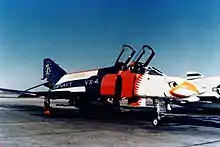 Bicentennial themed YF-4J Phantom II
Bicentennial themed YF-4J Phantom II F-5E NFWS in flight with F-4J VX-4 1985
F-5E NFWS in flight with F-4J VX-4 1985
U.S. Marine Corps
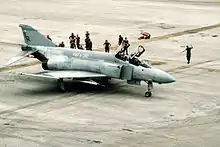
The U.S. Marines received their first F-4Bs in June 1962, with the VMFA-314 Black Knights at MCAS El Toro, California becoming the first operational squadron. In addition to attack variants, the Marines also operated several tactical reconnaissance RF-4Bs. Marine Phantoms from the VMFA-531 Gray Ghosts arrived in Vietnam on 10 April 1965, flying close air support missions from land bases as well as from USS America. Marine F-4 pilots claimed three enemy MiGs (two while on exchange duty with the USAF) at the cost of 75 aircraft lost in combat, mostly to ground fire, and four in accidents. On 18 January 1992, the last Marine Phantom, an F-4S, was retired by VMFA-112 Cowboys.[4]
 F-4N VMFA-531 dropping napalm 1982
F-4N VMFA-531 dropping napalm 1982 F-4N Phantoms of VFMA-323 in flight with CF-5A and CF-5B 1973
F-4N Phantoms of VFMA-323 in flight with CF-5A and CF-5B 1973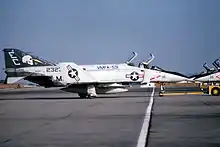 F-4N Phantom VMFA-531 ElToro 1982
F-4N Phantom VMFA-531 ElToro 1982 F-4S Phantom II of VMFA-333 in flight in 1985
F-4S Phantom II of VMFA-333 in flight in 1985 F-4S VMFA-235 in flight 1982
F-4S VMFA-235 in flight 1982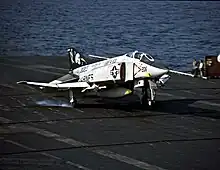 F-4N VMFA-531 CV-43 Apr80
F-4N VMFA-531 CV-43 Apr80 F-4Bs VMFA-542 Vietnam Jan1969
F-4Bs VMFA-542 Vietnam Jan1969 F-4J of VMFA-451 at NAS Miramar in 1976
F-4J of VMFA-451 at NAS Miramar in 1976 TA-4J Skyhawk and F-4 Phantom during air combat maneuvering 1980
TA-4J Skyhawk and F-4 Phantom during air combat maneuvering 1980
Frontline and Reserve
- VMFA-112 (MA) - Based at NAS Dallas, Texas (4th Marine Aircraft Wing / Marine Air Reserve)
- VMFA-115 (VE) - Based at MCAS Cherry Point, North Carolina until 1977, then MCAS Beaufort, South Carolina
- VMFA-122 (DC) - Based at MCAS El Toro, California, then MCAS Kaneohe Bay, Hawaii, then MCAS Beaufort, South Carolina
- VMFA-134 (MF) - Based at MCAS El Toro, California (4th Marine Aircraft Wing / Marine Air Reserve)
- VMFA-212 (WD) - Based at MCAS Kaneohe Bay, Hawaii
- VMFA-232 (WT) - Based at MCAS El Toro, California, MCAS Iwakuni Japan, then MCAS Kaneohe Bay, Hawaii
- VMFA-235 (DB) - Based at MCAS Kaneohe Bay, Hawaii
- VMFA-251 (DW) - Based at MCAS Beaufort, South Carolina
- VMFA-312 (DM) - Based at MCAS Beaufort, South Carolina
- VMFA-314 (VW) - Based at MCAS El Toro, California
- VMFA-321 (MG) - Based at Naval Air Facility Washington / Andrews AFB, Maryland (4th Marine Aircraft Wing / Marine Air Reserve)
- VMFA-323 (WS) - Based at MCAS El Toro, California
- VMFA-333 (DN) - Based at MCAS Beaufort, South Carolina
- VMFA-334 (WU) - Based at MCAS El Toro, California
- VMFA-351 (MC) - Based at NAS Atlanta / Dobbins AFB, Georgia (4th Marine Aircraft Wing / Marine Air Reserve)
- VMFA-451 (VM) - Based at MCAS Beaufort, South Carolina
- VMFA-513 (WF) - Based at MCAS El Toro, California, then MCAS Cherry Point, North Carolina
- VMFA-531 (EC) - Based at MCAS Cherry Point, North Carolina, then MCAS El Toro, California
- VMFA-542 (WH) - Based at MCAS El Toro, California
- VMCJ-1 (RM) - Based at MCAS Iwakuni, Japan
- VMCJ-2 (CY) - Based at MCAS Cherry Point, North Carolina
- VMFP-3 (RF) - Based at MCAS El Toro, California (Note: All Marine Corps RF-4B aircraft were consolidated into VMFP-3 in 1975)
NOTE: USMC squadrons shift their tail codes to the appropriate Carrier Air Wing (CVW) tail code when operating aboard aircraft carriers as part of an integrated USN/USMC CVW.
Fleet Replacement Training
These kind of units are known in Navy and Marine Corps parlance as Replacement Air Groups (RAG) or Fleet Replacement Squadrons (FRS). The purpose of this particular training units was to provide Fleet Marine Force (FMF) squadrons with F-4 Phantom-qualified aircrew and maintenance personnel. During the Vietnam War, they also furnished spare aircraft to replace those lost in combat.
- VMFAT-101 (SH) - Based at MCAS El Toro, California; later transferred to MCAS Yuma, Arizona
- VMFAT-201 - Based at MCAS Cherry Point, North Carolina; consolidated with VMFAT-101 in 1974
See also
References
- Citations
- ↑ Wilson, Stewart. McDonnell Douglas F-4 Phanton. Notebook Publications, 2000. ISBN 1-876722-00-2.
- ↑ Gerard Paloque "McDonnell F-4 Phantom, Vol. 2: US Air Force and Export Versions (Planes and Pilots)" ISBN 2-35250-149-0
- ↑ Thornborough and Davies 1994, p. 260.
- ↑ Crowther, M.J. and Baker, Rusty. The History of VMFA-112 Archived 2008-02-27 at the Wayback Machine Marine Fighter Attack Squadron 112, U.S. Marine Corps. Retrieved: 13 February 2008.
- Bibliography
- Thornborough, Anthony M. and Davies, Peter E. The Phantom Story. London: Arms and Armour Press, 1994. ISBN 1-85409-121-2.